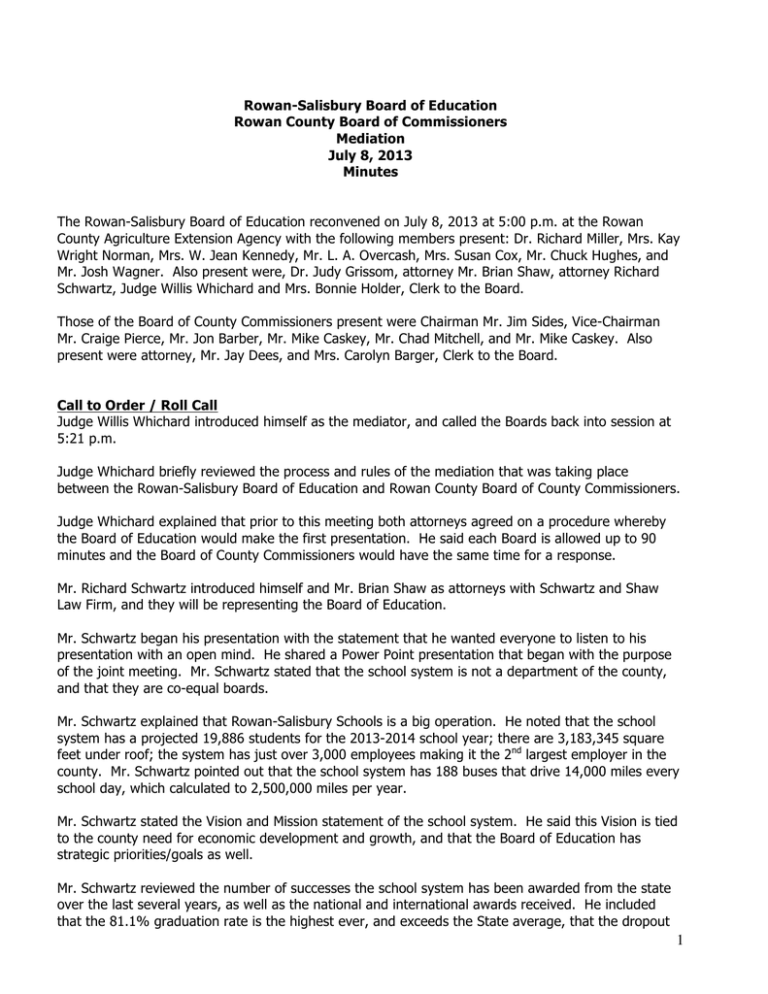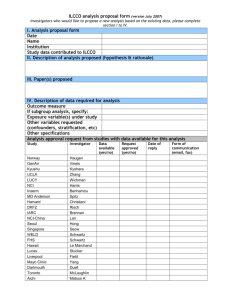Rowan-Salisbury Board of Education Rowan County Board of Commissioners Mediation
advertisement

Rowan-Salisbury Board of Education Rowan County Board of Commissioners Mediation July 8, 2013 Minutes The Rowan-Salisbury Board of Education reconvened on July 8, 2013 at 5:00 p.m. at the Rowan County Agriculture Extension Agency with the following members present: Dr. Richard Miller, Mrs. Kay Wright Norman, Mrs. W. Jean Kennedy, Mr. L. A. Overcash, Mrs. Susan Cox, Mr. Chuck Hughes, and Mr. Josh Wagner. Also present were, Dr. Judy Grissom, attorney Mr. Brian Shaw, attorney Richard Schwartz, Judge Willis Whichard and Mrs. Bonnie Holder, Clerk to the Board. Those of the Board of County Commissioners present were Chairman Mr. Jim Sides, Vice-Chairman Mr. Craige Pierce, Mr. Jon Barber, Mr. Mike Caskey, Mr. Chad Mitchell, and Mr. Mike Caskey. Also present were attorney, Mr. Jay Dees, and Mrs. Carolyn Barger, Clerk to the Board. Call to Order / Roll Call Judge Willis Whichard introduced himself as the mediator, and called the Boards back into session at 5:21 p.m. Judge Whichard briefly reviewed the process and rules of the mediation that was taking place between the Rowan-Salisbury Board of Education and Rowan County Board of County Commissioners. Judge Whichard explained that prior to this meeting both attorneys agreed on a procedure whereby the Board of Education would make the first presentation. He said each Board is allowed up to 90 minutes and the Board of County Commissioners would have the same time for a response. Mr. Richard Schwartz introduced himself and Mr. Brian Shaw as attorneys with Schwartz and Shaw Law Firm, and they will be representing the Board of Education. Mr. Schwartz began his presentation with the statement that he wanted everyone to listen to his presentation with an open mind. He shared a Power Point presentation that began with the purpose of the joint meeting. Mr. Schwartz stated that the school system is not a department of the county, and that they are co-equal boards. Mr. Schwartz explained that Rowan-Salisbury Schools is a big operation. He noted that the school system has a projected 19,886 students for the 2013-2014 school year; there are 3,183,345 square feet under roof; the system has just over 3,000 employees making it the 2nd largest employer in the county. Mr. Schwartz pointed out that the school system has 188 buses that drive 14,000 miles every school day, which calculated to 2,500,000 miles per year. Mr. Schwartz stated the Vision and Mission statement of the school system. He said this Vision is tied to the county need for economic development and growth, and that the Board of Education has strategic priorities/goals as well. Mr. Schwartz reviewed the number of successes the school system has been awarded from the state over the last several years, as well as the national and international awards received. He included that the 81.1% graduation rate is the highest ever, and exceeds the State average, that the dropout 1 rate of 2.9% is the lowest in over a decade. Mr. Schwartz noted that the minority graduation rate was up 4.3% as well. He explained the number of challenges that the school system faces in the budget cuts from the state, federal, and local levels. Mr. Schwartz acknowledged that the school system is receiving reduced funding as a result of declined student enrollment. However, the operation cost of the facilities has not decreased. On the contrary, in some areas there are increases. Secondly, the costs do not decrease proportionally to the reduction in enrollment. Mr. Schwartz noted that reduced federal funding due to sequestration ranges from 5.2% to 11.5% in various programs. That there is an increased cost in health insurance, unemployment and retirement costs, as well as utility costs. Mr. Schwartz advised that the school system’s population for free and reduced lunch is 62% as compared to Cabarrus County at 43%, Davie at 45%, and Stanley at 56%. During his presentation, Mr. Schwartz asked if the county wanted to maintain the education success that so many have worked to achieve, and does the citizens of this county want the school system to continue to improve. Mr. Schwartz also said that other areas at stake are local jobs, class size, direct classroom impact, school safety and security, maintaining school facilities, quality of life; local economic development, and real estate/property values. Mr. Schwartz explained that the BOE budget request to the county was a shortfall for current expense and that capital outlay was larger shortfall for a total of $29,111,900. Mr. Schwartz said excluding new construction, the amount would be $8,597,900, which is a manageable figure, and the money is available. The capital outlay and current expense can be funded without raising taxes. Mr. Schwartz explained that the county has a substantial fund balance and as of 6/30/2012 the balance of unrestricted funds was $28,304,454. He continued by noting that the county has a history of underestimating revenues, which is fine for conservative budgeting. However, there is going to be and has been more revenues than they project. Therefore, each year the county continues to accumulate an excessive fund balance. Mr. Schwartz said the county could afford to appropriate funding from either of three sources: county fund balance, lottery revenues, or debt service savings. He reminded everyone that the county citizens had already given the county approval to raise taxes in the 1993 and 2002 bond referenda. Mr. Schwartz said one of the disturbing downward trends is the decrease in funding for the schools. He summarized the appropriations over the last four years. He pointed out that the county funds on per pupil basis, but that is not how the school runs. The decrease in funding of $225,000 does not address actual costs. He noted that a decrease in enrollment of 142 students doesn’t do anything to affect the operating expenses. Mr. Schwartz suggested that as costs go up because of state mandates or inflation, appropriation must go up. Mr. Schwartz reviewed the per pupil appropriation from 2009 – 2014, and dollars adjusted for inflation is $120 less per pupil from three years ago. Mr. Schwartz said that Rowan County funds school current expense at below state average, and per pupil funding goes back to merger. He noted that prior to 1989, the city schools were funded 5th best 2 in the state, but the county was funded below state average. That was 25 years ago, and the school system has never received the state average. Mr. Schwartz explained that the school system has made severe cuts in the last 4 years that are cumulative. The system lost 200 positions and over $24M in state and federal money, as well as cuts of programs. Mr. Schwartz said the school system requested $4,601.00 because they were losing $1M in EduJobs and an estimated $2M in state reduction. The county appropriation increase was zero, but a $225,389 decrease. He explained with the BOE appropriation of $440,000 in fund balance, the total reduction in local funding would be $665,390. Mr. Schwartz summarized that with current expense continuation needs of $4,034,000 is just shy of the $4,601,000 requested by the school system. Mr. Schwartz reviewed the original expansion needs request and the revised request, noting that the total request of $693,000 was for safety and security for the schools. He pointed out that the increase of $275,000 for SROs in the middle schools was because the first request submitted assumed the Sheriff’s department would cover half of that cost. However, they did not receive the funding from the county. There was a reduction of $10,000 for lighting because of repairs made to existing lighting. Mr. Schwartz said that the county’s approach was to spend less and tighten your belt. A quote from the county manager said, “I expect Rowan-Salisbury Schools to make the appropriate overhead reductions and reliance upon their fund balance to meet their budget needs in 2013-2014.” Mr. Schwartz stated that the county’s expansion budget called for an increase of $787,094. He noted that the decrease in funding to the school system will directly impact the classroom, and that the system is appropriating their fund balance dangerous low. The $3,469,508 or 2% of the general budget is only one week’s reserve, and the need for fund balance is liquidity/cash flow, utility spikes, Emergencies, upfront payment source for grants that pay only as reimbursements, possibility of state or federal cutbacks mid–year, and the possibility of state or federal reversions. Mr. Schwartz said the BOE couldn’t continue recent history of depleting fund balance. Mr. Schwartz continued his presentation discussing capital outlay funding. He explained that this money can only be used for building, facility projects, and vehicles. State law language states that the county pays for facilities. The need in capital funding, including new construction totals $26,686,500. However the BOE is appropriating $750,000 from fund balance. Therefore, the request to the county was $25,936,500. The county is only appropriating $1,551,977 from sales tax revenue, which creates a $24,384,523 shortfall. Mr. Schwartz explained that without the new construction costs (new Woodleaf Elementary and Central Office) and less the county appropriation, the shortfall would be $3,870,511. Mr. Schwartz noted that 17 out of 40 school buildings/facilities are more than 70 years old, and the Ellis Street office tops the list at 108 years old. The Long Street administrative office is 90 years old. These buildings are costly to maintain. He said there are only 10 buildings less than 25 years old; that two-thirds of our buildings are 51 years old or older. Mr. Schwartz stated that the proposed Central Office construction is $8,000.00. He said it was worth noting that an outside building assessment was done and that letter stated that Long Street was 3 reported unsafe in 2008. Mr. Schwartz reviewed the cost savings from a consolidation of the five central offices. Mr. Schwartz went over the self-implemented energy management program and the reasons why this program would be beneficial to begin as soon as possible. First there would be an annual savings of $360,000. Therefor, in a little more than 10 years, it will pay for itself. He said if there is a delay in implementation there will be a delay in savings, older more costly equipment remain in the facilities, there would be Energy waste, and there are energy increases. Mr. Schwartz explained that the state requires a facility needs survey to be done every five (5) years. In 2010 the needs list was $128,428,653. He said in one example, a roofing engineer surveys all of the roofs, and gives a report of priority A, B, and C roofing needs (A being immediate). The priority A needs are were $1,941,900. The total county appropriation for capital outlay was $1,551,000, including roof repair or replacement. Mr. Schwartz expressed that the capital outlay needs have to be addressed, and the school systems request for capital outlay are modest. He said there has been gradual deterioration of county support for public schools from the county. Mr. Schwartz stated an average of $1,453,906 per year for capital outlay has been appropriated for the past five years, and this this is woefully inadequate and unsustainable to meet basic needs. He said regular capital outlay must maintain the county’s/citizens’/taxpayers’ investment in school facilities and meet basic needs. Mr. Schwartz pointed out the budget message from Superintendent Dr. Judy Grissom that read, “As the Rowan County Board of Commissioners considers this budget proposal, I hope that a spirit of cooperation and trust between the two boards will allow the children of Rowan County to achieve to their greatest potential. Rowan County students are depending on both boards working together to make wise budget decisions.” Mr. Schwartz concluded by saying, “Come together on a budget that is sustainable and doable for the students in this county.” Mr. Jay Dees requested a five-minute break. The meeting reconvened at 7:06 p.m. Mr. Dees said that it is a problem every year when it comes to the county funding the schools. He said it is the responsibility of the County of Rowan to provide a sound basic education. Mr. Dees said it comes to the biggest target today, the current expense fund. He read the statute and said an important piece is conformity with the educational goals and policies of the state and the local Board of Education, and the financial resources and fiscal policies of the board of county commissioners. Mr. Dees said it’s about policy, ability and fiscal responsibility. Mr. Dees said he was not going to give a 90-minute presentation, but ask the County Commissioners speak for themselves. Mr. Sides began by saying there are statutes that determine funding, and this problem tonight is not unique to Rowan County, but a first for Rowan County. 4 Mr. Sides said he believed the school board fails to recognize the problem is not with the County Commissioners and the funding given to the schools, but the problem is with the state and how it is funding the schools. He said the state is to fund current expense and the county to fund capital expense. Mr. Sides said the school board has failed to produce a budget. He said he thinks the board’s argument is with the state, not the commissioners. He stated that he didn’t believe that local government should make up the difference in funding when the stay reduces it’s funding. Mr. Craig Pierce said it would be great if the Board of Commissioners was in a position to give the school system more money, but it is just not there. He said that he understands that the Board of Education cares about the schools because that is all they have to look after. However, the Board of Commissioners has to fund other agencies. Mr. Pierce said the current expense funding should have been addressed earlier, but it wasn’t. He said he was time for the school board to spend the money they have. Mr. Pierce stated that he would like to offer the school system $30M for a new West are elementary school (consolidating Cleveland Elementary and Woodleaf Elementary) and have approximately $8M left for capital needs. He said he has worked on a plan since he took office in December. Mr. Barber said that he felt that for the last 12 years the Board of Commissioners has had some good times and have done an admirable job. He also commended the school system and the Board of Education for a job well done. He thanked the school administration and school board for the accomplishments they have made over the last several years. Mr. Barber said that either our elected bodies have to step up to the plate to resolve the problems that face our communities or we will dig ourselves into a hole we cannot dig ourselves out of. He said our county’s tax base is our problem because it has continued to decrease. However, the tax-exempt tax base has more than doubled and this is a major problem at the state level. He does believe that the state is not doing their part in funding education and there is a major problem with tax reform at the state level. Mr. Barber said he felt the Board of Commissioners could do better, and have done better in the past. Mr. Chad Mitchell said when it comes to school funding; he didn’t begrudge the Board of Education. He said they are between a rock and a hard place, because he knows many of their budgetary are dictated from the state. Mr. Mitchell stated that there have been many debates on who gets the dollars. He said he felt funding per pupil is the worst method of funding, and that the county should possibly come to a decision that the school system would get a percentage increase each year. How much of the county budget should be transitioned to the schools, he didn’t know. Mr. Mitchell suggested that there will have to begin to explore options that are around. He said other states are looking at other options as well. He said we could look into 4-day week. Schools could look into teaching students from home. Mr. Mitchell said he hoped that this process would end with this mediation tonight. He reminded everyone that Mr. Pierce has offered $30M to cover capital expense, and he said he would like to see the board of commissioners to at some time agree on a percentage of funds that goes to the school system each year. 5 Mr. Mitchell said he felt regular increases to the schools budget is a good compromise, but it would not be good to go to litigation. Mr. Caskey stated that he understands the school system has a hard job, but hopes with this process that the county can come together with them to come up with a solution. Ask about the long-term plan for the schools, if we continue to lose students. Thinks Mr. Pierce’s plan is a good plan. Is it fair to ask the taxpayers to fund monies that is going away. He said he thought with the commissioners saying that if they receive more funds, they would pass it on to the schools was a first step in trying to work together. Mr. Caskey said that he didn’t exactly agree with the presentation about the county fund balance. Mr. Sides recognized Mr. Page. He said the attorney did a great job and his job is to paint a great picture for the schools. He said that there has been quite a change in the fund balance. It is $16M or 12% of the budget. Cost $11M to run the county for a month. Mr. Page said that if things don’t turn around, they will be looking at raising taxes. When the bonds were passed for the $76M for building schools and the taxes were to be raised $.6. There was not a lottery. Instead of the commissioners raising taxes, they used lottery money to retire the debt. His point is that with lottery money, they did everything by the book and didn’t do anything wrong. He wanted his comments to be facts and not rebuttal. Finance Officer, Leslie Heidrick, said that when the Mr. Schwartz was talking about the sources of revenue the county could use to fund the schools, and not have a tax increase. Point out a couple things. County underestimating revenues. Are conservative and are supposed to be doing and they do appropriate fund balance. Want their revenues to exceed their projections slightly. She said they did have to use their fund balance in three of those years. To use fund balance for a debt service for an ongoing expense is not sound fiscally. Over the next four years, there is very little debt service reduction. Mr. Sides read a statute of how the county would pay the schools current expense. He said that he thinks that the county adequately supplies money to the schools. He said if the citizens want him to raise taxes, he will. However, he thinks he adequately funds the schools. Judge Whitchard thanked both boards and recessed. BOE reconvened at 9:00 p.m. 143-318.11(a)(3) attorney client privilege 143-318.11(a)(3) Miller moved. Norman seconded. Closed Session Miller. Seconded Wagner 6 Mediator explained to set a day and time to reconvene. Time of Thursday at 6:00 p.m. in the County Administration building. Adjournment Judge Whichard recess the meeting at 2:18 a.m. to reconvene at. ** moved to adjourn at a.m. seconded. Unanimously approved. (7:0) Dr. Richard Miller, Chairman Dr. Judy S. Grissom, Ed. D., Secretary 7





